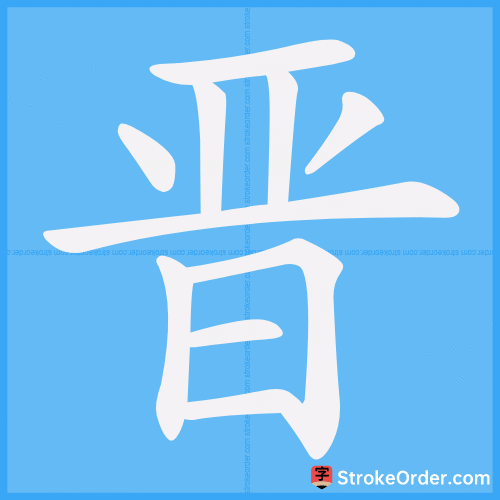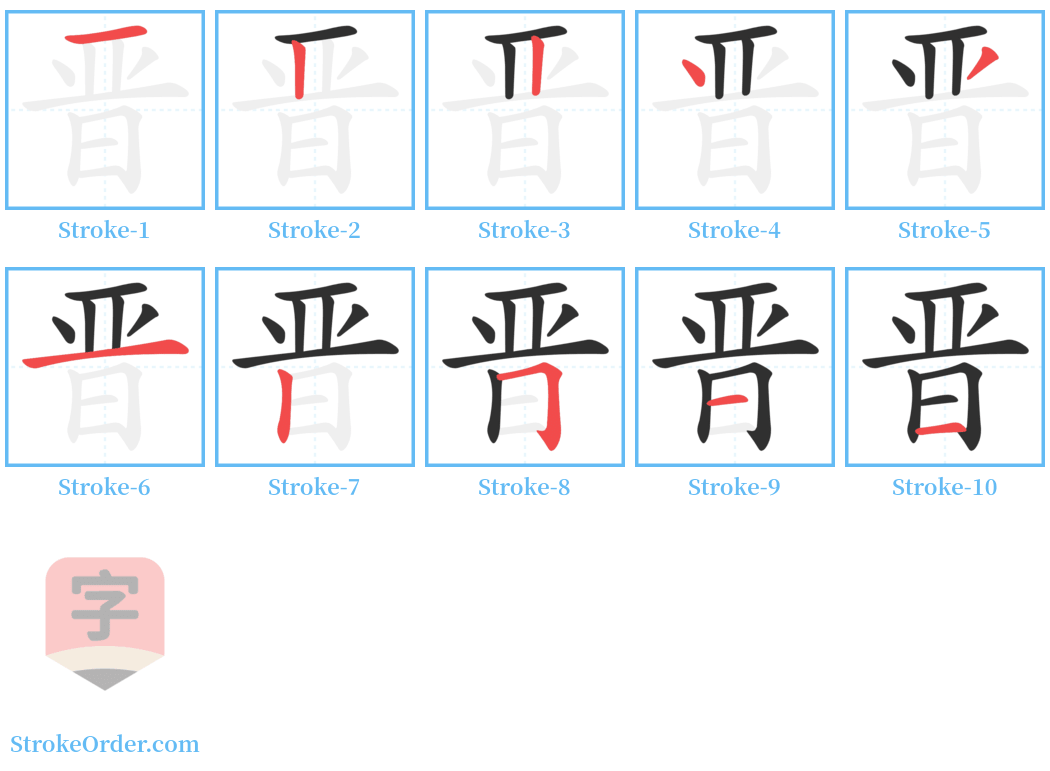晋 Stroke Order
Animated Stroke Order of 晋

Stroke Order Diagrams for 晋

Step-by-Step Handwriting Guide for 晋

Learn to Write Chinese Characters with Video Tutorials
Watch the video of writing the Chinese character "晋", learn the correct stroke order (笔顺) of the character "晋", and master the standard way of writing the character "晋".
Free Printable Handwriting Practice with Stroke Order: 晋
Printable Writing Practice Worksheet of "晋" in Portrait Orientation (Tian Zi Ge)

Printable Writing Practice Worksheet of "晋" in Landscape Orientation (Tian Zi Ge)

Information of 晋
Pinyin
jìn
Radical
日
Strokes
10 strokes
Usage
★★★★★
Definition
name of a dynasty
晋 (jìn)
1. Enter.
2. Name of a vassal state during the Zhou Dynasty in China.
3. Alternate name for Shanxi Province in China.
4. Name of a Chinese dynasty.
晋升. Promote: to elevate position, rank, or honor.
进见. Call on: to formally visit.
低. Low: in a lower position.
授予. Confer: to grant, especially in a public ceremony (e.g., degrees or noble titles).
进. Enter: move forward or advance.
名 (jìn)
1. Name of a vassal state during the Zhou Dynasty: Jin state. Established by King Cheng of Zhou, it predominantly occupied parts of modern-day Shanxi Province and southwest Hebei, spanning both banks of the Yellow River. It was later divided and fell to its ministers Han, Zhao, and Wei.
2. Name of a dynasty: Jin Dynasty.
3. The Sima Yan established himself as the emperor under the Jin name, with Luoyang as its capital, historically referred to as the Western Jin (265-316 AD), consisting of four emperors, eventually ending with the invasion of Qian Zhao.
4. Sima Rui ascended the throne in Jiankang, retaining control of the southern regions, historically known as the Eastern Jin (317-420 AD), comprising eleven emperors, ultimately replaced by Liu Yu.
5. During the Five Dynasties period, Shi Jingtang claimed the throne after defeating the Later Tang, naming his regime Jin, with Luoyang as its capital, known as the Later Jin (936-946 AD).
6. Abbreviation for Shanxi Province.
7. Name of a river: Jin River. Originates in the southwestern part of Mount Xuanweng in Taiyuan, Shanxi Province, splitting into northern, central, and southern channels, flowing east into the Fen River.
Shanxi 山西, Chahar 察哈爾|察哈尔 and Hebei 河北 (three provinces of the Republic of China in the period 1912-1936)
Jinzhou county-level city in Hebei / Jin Prefecture, established under the Northern Wei dynasty, centered on present-day Linfen 臨汾市|临汾市[Lin2 fen2 shi4] in Shanxi
Input Method for 晋
Pinyin
jin4
Wubi
gogj|gojf
Cangjie
mca
Zhengma
akk
Four Corner
10601
Unicode
U+664b
Same Pronunciation Characters